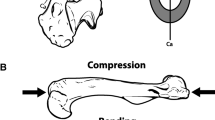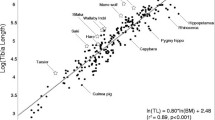Abstract
Summary
We propose a computational model with which to examine the evolution of bone. Our results indicate that changes in subsistence strategy have influenced the evolution of bone growth and mechanoregulation, and predict that bone size, stiffness, and structural strength may decrease in future generations, bringing increased risk of fracture and prevalence of osteoporosis.
Introduction
Archeological data suggest that bone size and strength have decreased over evolution. We hypothesize that changing evolutionary pressures and levels of physical activity, both arising from changes in subsistence strategy, have affected the evolution of bone. We propose a computational model with which to examine the evolution of bone growth and mechanoregulation due to the transitions from hunter–gatherer to agricultural to modern lifestyles.
Methods
The evolution of genes governing growth and mechanoregulation in a population of bones is simulated, where each individual is represented by a 2-D bone cross-section. Genetic variability is assumed to modulate growth through mechanoregulatory factors that direct periosteal expansion, endosteal expansion/infilling, and ash content accretion in response to strains incurred during walking.
Results
The model predicts decreases in cortical area and section modulus (a measure of structural strength) and increases in maximum compressive strain over the course of the simulation, meaning evolution of smaller, less strong, and less stiff bones is predicted for the population average. The model predicts small but continued decreases in size, strength, and stiffness in modern populations, despite the absence of a strong evolutionary advantage to efficient bones during this phase.
Conclusion
In conclusion, our results show that changing loading regimes and evolutionary pressures may have influenced the evolution of bone growth and mechanoregulation, and predict that bone size and strength may continue to decrease in future generations, bringing increased risk of fracture and prevalence of osteoporosis.







Similar content being viewed by others
References
Ruff CB (2005) Mechanical determinants of bone form: insights from skeletal remains. J Musculoskelet Neuronal Interact 5:202–212
Ruff CB, Larsen CS, Hayes WC (1984) Structural changes in the femur with the transition to agriculture on the Georgia coast. Am J Phys Anthropol 64:125–136
Martin RB (2003) Functional adaptation and fragility of the skeleton. In: Agarwal SC, Stout SD (eds) Bone loss and osteoporosis: an anthropological perspective. Springer, New York
Szulc P, Duboeuf F, Schott AM, Dargent-Molina P, Meunier PJ, Delmas PD (2006) Structural determinants of hip fracture in elderly women: re-analysis of the data from the EPIDOS study. Osteoporos Int 17:231–236
Giladi M, Milgrom C, Simkin A, Stein M, Kashtan H, Margulies J, Rand N, Chisin R, Steinberg R, Aharonson Z, Kedem R, Frankel V (1987) Stress fractures and tibial bone width. A risk factor. J Bone Jt Surg 69-B:326–329
Michaelsson K, Olofsson H, Jensevik K, Larsson S, Mallmin H, Berglund L, Vessby B, Melhus H (2007) Leisure physical activity and the risk of fracture in men. PLoS Med 4:e199
Booth FW, Lees SJ (2007) Fundamental questions about genes, inactivity, and chronic diseases. Physiol Genomics 28:146–157
Stock J, Pfeiffer S (2001) Linking structural variability in long bone diaphyses to habitual behaviors: foragers from the southern African Later Stone Age and the Andaman Islands. Am J Phys Anthropol 115:337–348
Ruff CB (2006) Gracilization of the modern human skeleton—The latent strength in our slender bones teaches lessons about human lives, current and past. Am Sci 94:508–514
Nowlan NC, Prendergast PJ (2005) Evolution of mechanoregulation of bone growth will lead to non-optimal bone phenotypes. J Theor Biol 235:408–418
Currey JD, Pitchford JW, Baxter PD (2007) Variability of the mechanical properties of bone, and its evolutionary consequences. J R Soc Interface 4:127–135
Roberts JAF, Pembrey ME (1985) An introduction to medical genetics. Oxford, New York
Currey JD, Alexander RM (1985) The thickness of the walls of tubular bones. J Zool 206:453–468
Kislev ME, Hartmann A, Bar-Yosef O (2006) Early domesticated fig in the Jordan Valley. Science 312:1372–1374
Cook DC, Buikstra JE (1979) Health and differential survival in prehistoric populations: prenatal dental defects. Am J Phys Anthropol 51:649–664
Taylor SJG, Walker PS (2001) Forces and moments telemetered from two distal femoral replacements during various activities. J Biomech 34:839–848
McCammon RW (1970) Human growth and development. Charles C Thomas, Springfield
Courtland HW, Nasser P, Goldstone AB, Spevak L, Boskey AL, Jepsen KJ (2008) Fourier transform infrared imaging microspectroscopy and tissue-level mechanical testing reveal intraspecies variation in mouse bone mineral and matrix composition. Calcif Tissue Int 83:342–353
Martin RB, Burr DB, Sharkey NA (1998) Skeletal tissue mechanics. Springer, New York
Spatz HC, Oleary EJ, Vincent JFV (1996) Young's moduli and shear moduli in cortical bone. Proc R Soc Lond B Biol Sci 263:287–294
Prendergast PJ, Taylor D (1994) Prediction of bone adaptation using damage accumulation. J Biomech 27:1067–1076
Carter DR, van der Meulen MCH, Beaupre GS (1996) Mechanical factors in bone growth and development. Bone 18:S5–S10
Duda GN, Heller M, Albinger J, Schulz O, Schneider E, Claes L (1998) Influence of muscle forces on femoral strain distribution. J Biomech 31:841–846
Mulvihill BM, McNamara LM, Prendergast PJ (2008) Loss of trabeculae by mechano-biological means may explain rapid bone loss in osteoporosis. J R Soc Interface 5:1243–1253
Garn SM (1970) The earlier gain and the later loss of cortical bone, in nutritional perspective. Charles C Thomas, Springfield
Currey JD, Butler G (1975) Mechanical properties of bone tissue in children. J Bone Joint Surg Am 57:810–814
Tommasini SM, Nasser P, Hu B, Jepsen KJ (2008) Biological co-adaptation of morphological and composition traits contributes to mechanical functionality and skeletal fragility. J Bone Miner Res 23:236–246
Price C, Herman B, Lufkin T, Goldman H, Jepsen K (2005) Genetic variation in bone growth patterns defines adult mouse bone fragility. J Bone Miner Res 20:1983–1991
Jepsen KJ, Courtland HW, Nadeau JH (2010) Genetically determined phenotype covariation networks control bone strength. J Bone Miner Res 25:1581–1593
Agarwal SC, Grynpas MD (1996) Bone quantity and quality in past populations. Anat Rec 246:423–432
Bennike P, Bohr H (1990) Bone mineral content in the past and present. In: Christiansen C, Overgaard K (eds) Osteoporosis 1990: proceedings of the 3 rd international symposium on osteoporosis. Osteopress Aps, Copenhagen, pp 89–91
Ekenman I, Eriksson SAV, Lindgren JU (1995) Bone density in medieval skeletons. Calcif Tissue Int 56:355–358
Trinkaus E, Stringer CB, Ruff CB, Hennessy RJ, Roberts MB, Parfitt SA (1999) Diaphyseal cross-sectional geometry of the Boxgrove 1 Middle Pleistocene human tibia. J Hum Evol 37:1–25
van der Meulen MC, Beaupré GS, Carter DR (1993) Mechanobiologic influences in long bone cross-sectional growth. Bone 14:635–642
Larsen CS (1995) Biological changes in human-populations with agriculture. Annu Rev Anthropol 24:185–213
Habicht J, Yarbrough C, Martorell R, Malina R, Klein R (1974) Height and weight standards for preschool children: how relevant are ethnic differences in growth potential? Lancet 303:611–615
Komlos J, Lauderdale B (2007) The mysterious trend in American heights in the 20th century. Ann Hum Biol 34:206–215
Hyldstrup L, Andersen T, McNair P, Breum L (1993) Bone metabolism in obesity: changes related to severe overweight and dietary weight reduction. Acta Endocrinol 129:393
Acknowledgements
The authors would like to thank Professors Patrick Prendergast and Roberto Fajardo for their advice on this study.
Conflicts of interest
None.
Author information
Authors and Affiliations
Corresponding author
Additional information
Funding Sources
NCN has received funding from the Fulbright Program and the Irish Research Council for Science, Engineering and Technology. This work was partially supported by the NIH (AR44927, AR56639).
Rights and permissions
About this article
Cite this article
Nowlan, N.C., Jepsen, K.J. & Morgan, E.F. Smaller, weaker, and less stiff bones evolve from changes in subsistence strategy. Osteoporos Int 22, 1967–1980 (2011). https://doi.org/10.1007/s00198-010-1390-3
Received:
Accepted:
Published:
Issue Date:
DOI: https://doi.org/10.1007/s00198-010-1390-3




